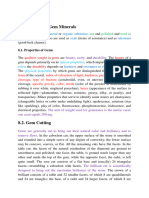0 ratings0% found this document useful (0 votes)
12 viewsWRPM 2-1
WRPM 2-1
Uploaded by
MekonenThe document discusses consumptive and non-consumptive uses of water resources. It defines consumptive use as water that is not returned to its source, and provides examples. The document also discusses the effects of consumptive use, non-consumptive uses of surface and groundwater, and compatibility of different water uses.
Copyright:
© All Rights Reserved
Available Formats
Download as PPTX, PDF, TXT or read online from Scribd
WRPM 2-1
WRPM 2-1
Uploaded by
Mekonen0 ratings0% found this document useful (0 votes)
12 views18 pagesThe document discusses consumptive and non-consumptive uses of water resources. It defines consumptive use as water that is not returned to its source, and provides examples. The document also discusses the effects of consumptive use, non-consumptive uses of surface and groundwater, and compatibility of different water uses.
Copyright
© © All Rights Reserved
Available Formats
PPTX, PDF, TXT or read online from Scribd
Share this document
Did you find this document useful?
Is this content inappropriate?
The document discusses consumptive and non-consumptive uses of water resources. It defines consumptive use as water that is not returned to its source, and provides examples. The document also discusses the effects of consumptive use, non-consumptive uses of surface and groundwater, and compatibility of different water uses.
Copyright:
© All Rights Reserved
Available Formats
Download as PPTX, PDF, TXT or read online from Scribd
Download as pptx, pdf, or txt
0 ratings0% found this document useful (0 votes)
12 views18 pagesWRPM 2-1
WRPM 2-1
Uploaded by
MekonenThe document discusses consumptive and non-consumptive uses of water resources. It defines consumptive use as water that is not returned to its source, and provides examples. The document also discusses the effects of consumptive use, non-consumptive uses of surface and groundwater, and compatibility of different water uses.
Copyright:
© All Rights Reserved
Available Formats
Download as PPTX, PDF, TXT or read online from Scribd
Download as pptx, pdf, or txt
You are on page 1of 18
Chapter 2
Utilization of Water Resources
Utilization of Water Resource
Water required for various purposes may come from
groundwater or surface resources such as lakes, reservoirs,
and rivers.
Consumptive and Non-consumptive uses of Water
The distinction between consumptive and non-consumptive
use of water is a critical aspect of effective water
management.
Consumptive use of water : no water is returned to the
water source.
Non-consumptive water use :water is returned to the
source for use by others downstream.
Water used consumptively diminishes the source and is not
available for other uses; whereas non-consumptive water use
does not diminish the source or impair future water use.
Utilization of Water Resource
Consumptive versus Non-Consumptive Use of Water:
1.0 Definition of Consumptive Use
a. Consumptive use is defined as water withdrawn that
is not directly returned to its original source.
b. Definitions Applied to All Water Uses: Possibly, it
is erroneous to define certain water uses as
“consumptive” and others as “non consumptive.”
All uses are partially consumptive and partially non-
consumptive. The following examples are illustrative.
2.0 Examples of Consumptive Use Patterns
Utilization of Water Resource
3.0 The Effect of Consumptive Use
the water is not returned back to the water source and
is no longer available for use by anyone downstream.
when water use is non-consumptive, water is returned
back to the water source and is available for use by
other water users downstream.
Let us Consider these admittedly simplistic examples:
Utilization of Water Resource
a. If Water User #1 makes non-consumptive use of the
water and returns all the water he has withdrawn, User
#2 can make use of all the water withdrawn by User #1.
If User #2 again makes non-consumptive use, User #3
downstream can again make use of all the water
withdrawn by User #2. An infinite number of such non-
consumptive users can make use of the water.
Utilization of Water Resource
b. If User #1 consumes 50 % of the water withdrawn and
returns 50 % to the water source, User #2 downstream
can make use of 50 % of the water withdrawn by User
#1. After User #2 consumed 50 %, User #3 downstream
can make use of only 25 % of what User #1 withdrew.
User #10 far downstream can make use of less than 1.0
% of what User #1 withdrew.
Utilization of Water Resource
Non-Consumptive Use of Surface and Groundwater
Consumptive water use: causes diminishment of the source
at the point of appropriation.
Diminishment is defined as to make smaller or less in
quantity, rate of flow, or availability.
Non-consumptive Water Use, Surface Water
By-pass reach: A water use may be consumptive to a specific
reach of a stream when water is diverted, used, and returned to
the same source at a point downstream not in close proximity
to the point of diversion. The stream reaches between the
point of withdrawal and point of discharge is the by-pass
reach.
Utilization of Water Resource
Surface water use is non-consumptive when there is no
diversion from the water source or diminishment of the
source:
Hydroelectric projects
beautification ponds and fish hatcheries
Transportation purpose
Utilization of Water Resource
Non-consumptive Water Use, Groundwater
when there is no diminishment of the source.
In order not to diminish the source, the withdrawn water is
injected or infiltrated immediately back to the aquifer.
Conclusions about Consumptive &Non-Consumptive use
The non-consumptive use of water allows multiple uses of
the water by others downstream.
The consumptive use of water means the water is lost to
the system. Users downstream either have to rely on other
sources of water (like tributaries downstream) to
compensate the shortage or use lesser water.
Utilization of Water Resource
Single and Multi-Purpose Water uses
Water resources development projects are usually classified
based on the service they provide as:
A single-purpose approach serves only one basic purpose
therefore this type of water development and management do
not reflect the realities of poor people’s water use.
A multiple-purpose approach can maximize the healthy
benefits and productive potential of available water supplies
leading to increased incomes, improved health and reduced
workloads for women and children.
Utilization of Water Resource
Taking an integrated, multiple-purpose approach to water
development and management is an opportunity to advance progress
on three of the eight Millennium Development Goals (MDG’s):
Goal 1: To eradicate extreme poverty and hunger;
Goal 3: To promote gender equality and empower women and;
Goal 7: To ensure environmental sustainability.
The current single-purpose perspective, which dominates thinking on
water development and service provision, has led to domestic water-
supply schemes that forbid the use of water for production or that
supply too little water for any but the most basic domestic needs, and
to irrigation schemes that ignore the need for domestic or household
level production activities.
Utilization of Water Resource
What is a multi-purpose approach?
In essence, a multi-purpose approach serves two or more
purpose and involves
(1) Assessing the range of water needs in collaboration with
end users,
(2) Examining the water sources available from rainwater to
wastewater to piped systems,
(3) Matching water supplies to needs based on the quantity,
quality and reliability required for various purposes.
Utilization of Water Resource
Three crucial aspects of a multi-purpose approach
that are neglected in traditional approaches to water
supply are:
participation of local communities,
identification of all water needs, and
consideration of the different water sources
available.
Utilization of Water Resource
Ways of accommodating multi-purpose water uses
Irrigation systems can be adapted by
Releasing water for household uses and bathing
Building or reviving community domestic-supply reservoirs
Building steps in canal banks for laundry
Adding pipes, canals and taps to bring water into houses
Promoting low-cost, point-of-use treatment for drinking water
Sinking shallow wells to tap cleaner ‘seepage’ water
Adding access and crossing points to canals for cattle
Maintaining flows to preserve fish populations
Building fish-friendly structures in sluices and canals.
Utilization of Water Resource
Domestic water supply systems can be adapted by:
Increasing water discharge to allow productive
activities
Providing water without interruptions
Adding cattle troughs to supply points
Adding storage tanks
Adding micro-irrigation systems
Using different water sources depending on quality
needs
Promoting reuse of household “grey” (waste) water
Utilization of Water Resource
Use of other water sources can be maximized by:
Working with the private sector to promote the use of
affordable pumps and drip irrigation kits (also
applies to domestic systems)
Promoting community/rooftop rainwater harvesting
Enlarging ponds and wells
Developing gravity-flow systems to pipe in stream-
water
Promoting credit and access to other inputs to enable
people to make use of productive water supplies
(applies to all)
Utilization of Water Resource
Benefits of a multi-purpose approach:
Reducing poverty and improving livelihoods
Fighting hunger and surviving droughts
Improving health
Improving gender equity
Increasing system sustainability
Utilization of Water Resource
Compatibility of Different Uses of Water
If the requirements of water for different uses are compatible(be
used together without problems or conflict) with one another,
effective use of the water will be made.
Eg. Hydropower development
is not a consumptive use of water. Any water released for the
other purposes may be used for power. At a base load plant, the
water requirement may be revised for other purposes requiring
uniform flow. At a peaking plant, a regulating pond can be
provided to smooth out the fluctuation of power releases.
However, it is usually necessary to allocate a certain amount of
storage for power use, since the seasonal variation in power
demand may not coincide with the demand for other uses.
You might also like
- The Subtle Art of Not Giving a F*ck: A Counterintuitive Approach to Living a Good LifeFrom EverandThe Subtle Art of Not Giving a F*ck: A Counterintuitive Approach to Living a Good LifeRating: 4 out of 5 stars4/5 (5979)
- The Gifts of Imperfection: Let Go of Who You Think You're Supposed to Be and Embrace Who You AreFrom EverandThe Gifts of Imperfection: Let Go of Who You Think You're Supposed to Be and Embrace Who You AreRating: 4 out of 5 stars4/5 (1112)
- Never Split the Difference: Negotiating As If Your Life Depended On ItFrom EverandNever Split the Difference: Negotiating As If Your Life Depended On ItRating: 4.5 out of 5 stars4.5/5 (898)
- Hidden Figures: The American Dream and the Untold Story of the Black Women Mathematicians Who Helped Win the Space RaceFrom EverandHidden Figures: The American Dream and the Untold Story of the Black Women Mathematicians Who Helped Win the Space RaceRating: 4 out of 5 stars4/5 (932)
- Grit: The Power of Passion and PerseveranceFrom EverandGrit: The Power of Passion and PerseveranceRating: 4 out of 5 stars4/5 (619)
- Shoe Dog: A Memoir by the Creator of NikeFrom EverandShoe Dog: A Memoir by the Creator of NikeRating: 4.5 out of 5 stars4.5/5 (546)
- The Hard Thing About Hard Things: Building a Business When There Are No Easy AnswersFrom EverandThe Hard Thing About Hard Things: Building a Business When There Are No Easy AnswersRating: 4.5 out of 5 stars4.5/5 (356)
- Her Body and Other Parties: StoriesFrom EverandHer Body and Other Parties: StoriesRating: 4 out of 5 stars4/5 (831)
- Elon Musk: Tesla, SpaceX, and the Quest for a Fantastic FutureFrom EverandElon Musk: Tesla, SpaceX, and the Quest for a Fantastic FutureRating: 4.5 out of 5 stars4.5/5 (476)
- The Emperor of All Maladies: A Biography of CancerFrom EverandThe Emperor of All Maladies: A Biography of CancerRating: 4.5 out of 5 stars4.5/5 (275)
- The Little Book of Hygge: Danish Secrets to Happy LivingFrom EverandThe Little Book of Hygge: Danish Secrets to Happy LivingRating: 3.5 out of 5 stars3.5/5 (424)
- The World Is Flat 3.0: A Brief History of the Twenty-first CenturyFrom EverandThe World Is Flat 3.0: A Brief History of the Twenty-first CenturyRating: 3.5 out of 5 stars3.5/5 (2272)
- The Yellow House: A Memoir (2019 National Book Award Winner)From EverandThe Yellow House: A Memoir (2019 National Book Award Winner)Rating: 4 out of 5 stars4/5 (99)
- Devil in the Grove: Thurgood Marshall, the Groveland Boys, and the Dawn of a New AmericaFrom EverandDevil in the Grove: Thurgood Marshall, the Groveland Boys, and the Dawn of a New AmericaRating: 4.5 out of 5 stars4.5/5 (270)
- The Sympathizer: A Novel (Pulitzer Prize for Fiction)From EverandThe Sympathizer: A Novel (Pulitzer Prize for Fiction)Rating: 4.5 out of 5 stars4.5/5 (125)
- Team of Rivals: The Political Genius of Abraham LincolnFrom EverandTeam of Rivals: The Political Genius of Abraham LincolnRating: 4.5 out of 5 stars4.5/5 (235)
- A Heartbreaking Work Of Staggering Genius: A Memoir Based on a True StoryFrom EverandA Heartbreaking Work Of Staggering Genius: A Memoir Based on a True StoryRating: 3.5 out of 5 stars3.5/5 (232)
- Kahsay Final ProjectDocument83 pagesKahsay Final ProjectMekonen100% (2)
- On Fire: The (Burning) Case for a Green New DealFrom EverandOn Fire: The (Burning) Case for a Green New DealRating: 4 out of 5 stars4/5 (75)
- The Unwinding: An Inner History of the New AmericaFrom EverandThe Unwinding: An Inner History of the New AmericaRating: 4 out of 5 stars4/5 (45)
- Milat Haile Research ProposalDocument13 pagesMilat Haile Research ProposalMekonenNo ratings yet
- Kidist MeressaDocument25 pagesKidist MeressaMekonenNo ratings yet
- Underground Mining MethodDocument73 pagesUnderground Mining MethodMekonenNo ratings yet
- KibomDocument49 pagesKibomMekonenNo ratings yet
- CH 3Document29 pagesCH 3MekonenNo ratings yet
- Teshome HagosDocument2 pagesTeshome HagosMekonenNo ratings yet
- Chapter One&2Document16 pagesChapter One&2MekonenNo ratings yet
- Ore Deposit Modeling 1Document184 pagesOre Deposit Modeling 1MekonenNo ratings yet
- Mineralogy Handout-MK GeneralDocument67 pagesMineralogy Handout-MK GeneralMekonenNo ratings yet
- Chapter 3&4 5Document14 pagesChapter 3&4 5MekonenNo ratings yet
- Chapter 1Document46 pagesChapter 1MekonenNo ratings yet
- CH-8 Introduction To Gem MineralsDocument3 pagesCH-8 Introduction To Gem MineralsMekonenNo ratings yet
- Chapter 1, Lect. 1Document37 pagesChapter 1, Lect. 1MekonenNo ratings yet
- DairyuDocument6 pagesDairyuMekonenNo ratings yet
- Gere 2-2Document11 pagesGere 2-2MekonenNo ratings yet
- Chapter 4Document61 pagesChapter 4MekonenNo ratings yet
- Mine D 1 Chap 5Document33 pagesMine D 1 Chap 5MekonenNo ratings yet
- Chap 1Document34 pagesChap 1MekonenNo ratings yet
- AtwetINTERNSHIP REPORT 2016 E.C - 24082019570 (1) - 1Document51 pagesAtwetINTERNSHIP REPORT 2016 E.C - 24082019570 (1) - 1MekonenNo ratings yet
- Tcexam Module 20 202304010738-LASTDocument17 pagesTcexam Module 20 202304010738-LASTMekonenNo ratings yet





























































